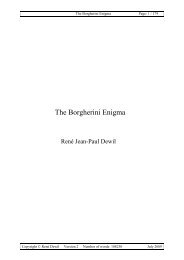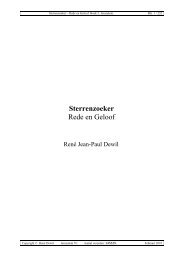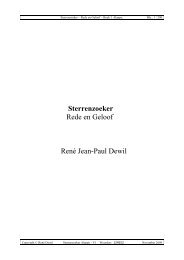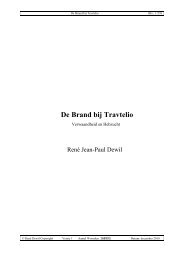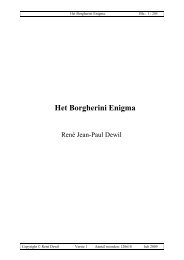A visual Journey into the Bible The Book of Genesis
A visual Journey into the Bible The Book of Genesis
A visual Journey into the Bible The Book of Genesis
You also want an ePaper? Increase the reach of your titles
YUMPU automatically turns print PDFs into web optimized ePapers that Google loves.
A Visual <strong>Journey</strong> <strong>into</strong> <strong>the</strong> <strong>Bible</strong> Page: 38<br />
energetically waves his arms. <strong>The</strong> animals stand out in <strong>the</strong> brown colours. Bassano<br />
painted in extra patches <strong>of</strong> light to accentuate <strong>the</strong> line <strong>of</strong> <strong>the</strong> animals and he added<br />
animals in white at regular intervals such as a white dog and a white horse. This was a<br />
painter who mastered light and darkness as well as T<strong>into</strong>retto.<br />
Bassano was a precursor <strong>of</strong> <strong>the</strong> dramatic use <strong>of</strong> <strong>the</strong> contrast <strong>of</strong> light and darkness and<br />
in this late painting – it dates from around 1590, while Bassano died in 1592 – we<br />
sense fully <strong>the</strong> coming <strong>of</strong> Caravaggio and <strong>of</strong> Baroque. <strong>The</strong> scene is filled with epic<br />
and dynamism, emotion and movement. <strong>The</strong> disorderly animals, and <strong>the</strong> motions <strong>of</strong><br />
<strong>the</strong> figures grasping <strong>the</strong> animals and driving <strong>the</strong>m forward is eminently Baroque.<br />
Energy, motion, passion, involvement in <strong>the</strong> scene, contrasts <strong>of</strong> black and white are<br />
all <strong>the</strong> ingredients <strong>of</strong> <strong>the</strong> Baroque and <strong>the</strong>se can be found accomplished in <strong>the</strong> Bassano<br />
picture. Jacopo Bassano combined <strong>the</strong> style elements <strong>of</strong> many o<strong>the</strong>r masters to <strong>the</strong><br />
way <strong>of</strong> painting that would conquer <strong>the</strong> seventeenth century.<br />
Where did Baroque art originate It was probably only in <strong>the</strong> rich grand cities <strong>of</strong><br />
Western Europe that had accumulated wealth that such an art form could thrive.<br />
Venice was in a period <strong>of</strong> slow decline. But because <strong>of</strong> <strong>the</strong> mass <strong>of</strong> funds in <strong>the</strong> city it<br />
continued to augment its revenues <strong>of</strong> trade. <strong>The</strong> same was true <strong>of</strong> Antwerp. And in<br />
Rome, <strong>the</strong> Roman Catholic Popes stood at <strong>the</strong> centre <strong>of</strong> a steady inflow <strong>of</strong> money<br />
from <strong>the</strong> sale <strong>of</strong> indulgences and <strong>of</strong> parts <strong>of</strong> <strong>the</strong> revenues <strong>of</strong> <strong>the</strong> European clergy. All<br />
this wealth was spent in <strong>the</strong> late sixteenth century and even more in <strong>the</strong> seventeenth<br />
century, to at least a significant extent on art. No art form represents more <strong>the</strong><br />
spending <strong>of</strong> riches than Baroque art. Its flamboyancy declares a joy <strong>of</strong> living, a<br />
confidence in wealth, a desire to dwell in extravagant beauty and <strong>the</strong> will to boast<br />
with <strong>the</strong> acquired abundance. <strong>The</strong> middle class <strong>of</strong> traders and merchants could<br />
compete with <strong>the</strong> courts <strong>of</strong> Europe in magnificence and thus affirmed its power. In<br />
Venice, T<strong>into</strong>retto, Veronese and Jacopo Bassano were <strong>the</strong> foremost proponents <strong>of</strong><br />
this movement.<br />
Noah’s Sacrifice<br />
Joseph Anton Koch (1768-1839). Staatliche Museen zu Berlin Preussischer<br />
Kulturbesitz. Nationalgalerie – Berlin. 1814.<br />
Joseph Anton Koch was born in <strong>the</strong> Tyrol region <strong>of</strong> Austria, but <strong>the</strong> German Bishop<br />
<strong>of</strong> Augsburg remarked him and recommended him to go to an art school. He first<br />
studied in Augsburg, and <strong>the</strong>n could attend <strong>the</strong> Karlsschule <strong>of</strong> Stuttgart from 1785 on.<br />
In 1791 he ran away from this rigid and hard school and travelled through <strong>the</strong> Alps. In<br />
1795 an English Maecenas gave him a scholarship to go to Rome and he became<br />
acquainted <strong>the</strong>re with <strong>the</strong> painter Jakob Asmus Carstens. He shared a workshop with<br />
Carstens in Rome. He also learnt to know o<strong>the</strong>r German painters. He was particularly<br />
fond <strong>of</strong> a small village outside Rome, called Olevano Romano, and married <strong>the</strong><br />
daughter <strong>of</strong> a winegrower <strong>the</strong>re. He painted mainly <strong>the</strong> country landscapes <strong>of</strong> <strong>the</strong><br />
Roman surroundings. Throughout his whole life he would thus remain a painter <strong>of</strong><br />
Copyright ©: René Dewil Date: October, 24 2000



